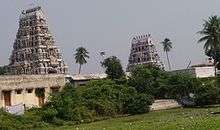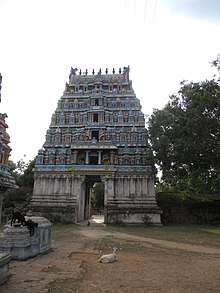Ashta Veeratta Stalam
Ashta Veeratta Stalam (also called Ashtaveertanam or Atta Veeratanam) are the eight temples associated with the legend of Hindu god Shiva destroying eight different demons namely Andakasuran, Gajasuran, Jalandasuran, Thirupuradhi, Kaman, Arjunan, Dakshan and Taaragasuran. These temples are built signifying each of his victories in the war,[1] Seven out of the eight temples are also classified as Paadal Petra Sthalam, the temples of Shiva, that are reverred in Tevaram, 7th century Saiva canonical work written by Tamil saint poets known as the nayanars.[2] The presiding deity in all the temple is called Veerateeswarar.
The temples
As per Hindu legend, Veeratanam in Tamil refers to Hindu god Shiva destroying Asura (demons) in eight different sequences. Shiva is one of Hindu trinity indicating destruction. The eight places where he performed the divine act are came to Ashta Veeratanam and the eight temples built in these places are called Ashta Veeratta Stalam.
List of temples based on legend
| S.No. | Name of the temple | Photo | Notes/Beliefs |
|---|---|---|---|
| 1 | Veerateeswarar temple, Thirukovilur |  |
Shiva appeared in the form of Andakasuramurthy to slay the demon king Andhakasura. Andakasura was a demon who attained powers close to immortality on account of his severe penance to Brahma, the Hindu god of creation. The boon attained had just one condition that when he lusts his mother, he would be killed. He made undue use of his powers and was troubling humans and celestial deities. During one such encounters, he started lusting toward Parvathi, the wife of Shiva and who was like his mother. Shiva appeared as Andakasuramurthy and slayed Andaka with his trident. Realising his mistake, he pleaded Shiva to make him a devotee of his in the next birth. It is believed that Shiva readily agreed and Andaka was born as Gana Bhringi.[3] |
| 2 | Veerateeswarar temple, Thiruvathigai | .jpg) |
The three sons of Taraka obtained boons from Brahma and built an impregnable fortress on earth. On account of their atrocious activities, mother earth prayed to Shiva for rescue. Shiva burnt down the fort and was about to attack the trio, but they begged for mercy. He made two of them as Dvarapalas and one as his damaroo, which he sports in his right hand. The whole incident is believed to have taken place in Thiruvathigai on the banks of Kedilam.[4] The original name of the place was called Tripura Dahanam, which went on to become Thiruvathigai.[5] During Tripurasamharam, the killing of Tripurantaka, Shiva forgot to worship Ganesha before setting out for the battle. He realized it and came back to worship Ganesha and went ahead to win the demon. The same legend is associated with Aksheeswaraswamy Temple, Acharapakkam and Thiruvirkolam Sri Tripuranthaka Swami temple.[6] |
| 3 | Veerateeswarar temple, Korukkai | .jpg) |
Kamadeva, the cupid, was married to Ratī. One of the principal myths regarding Kama is that of his incineration by Shiva, the Kama Dahana. It occurs in its most developed form in the Matsya Purana (verses 227-255)[7] but is also repeated with variants in the Shaiva Purana and other Puranas.[8]Indra and the gods were suffering at the hands of the demon Tarakasura. Tarakasura obtained superior powers from Brahma from his severe penance. He could not be defeated by anyone except by Shiva's son. Brahma advised the celestial deities that Parvati should get an offspring from lord Shiva who would be able to defeat Taraka. Indra requested Kamadeva to break Shiva's penance. To create a congenial atmosphere, Kamadeva (Madana) created an untimely spring (akāla-vasanta). After he awoke Shiva with a flower arrow, Shiva, furious, opened his third eye, which incinerated Madana instantaneously and he is turned into ash. Lord Shiva agreed with Parvati's proposal and their pooja resulted the birth of lord karthikeya who defeated Taraka.[9] Rati prayed to Indra, who along with celestial deities prayed to Shiva that it was under their request that Kama disturbed his penance. Shiva gave a boon that Kama would be reborn in Treta Yuga in the womb of Krishna's wife Rukmini as Pradyumna and marry Rati.[10] |
| 4 | Kandeeswarar Temple, Kandiyur | Brahma, the Hindu god of creation and Shiva, the Hindu god of destruction, had originally five heads. Parvati, the wife of Shiva, once got confused and performed patha pooja (ablution of feet, considered an act of respect) to Brahma, instead of Shiva. Shiva got enraged and cut off one of Brahma's heads; the cut head got stuck in his hand due to Brahma's curse. To get rid off the sin, Shiva worshipped Vishnu at Thirukarambanur as Bhikshatana, where a part of his sin was relieved. He got his curse fully relieved after visiting Vishnu at Thirukandiyur and taking a holy dip in the temple tank, Kamala Pushkarani. Since Vishnu relieved (vimochana) the sin (saabha) of Shiva (also called Hara), the temple is called Hara Sabha Vimochana temple. After the incident, the tank came to be known as Kapala Theertham (kapala indicates skull). Shiva was pleased and he built the Hara Sabha Vimochana temple and also built a temple for himself near it. | |
| 5 | Amritaghateswarar-Abirami Temple,Thirukkadaiyur | 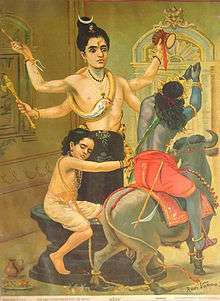 |
Near the temple of Tirukkadaiyur, there lived a sage named Mrikandu and his wife Marudmati. They were both devotees of Shiva and worshiped him day and night for many years, asking to be graced with a child. After many years of penance, Shiva appeared to Mrikandu and Marudmati. He told them that he heard their prayers and would give them a choice: they could either have a gifted son who would live to be only sixteen, or a son of low intelligence who would live a long life. Mrikandu and Marudmati chose the former, and were blessed with Markandeya, an exemplary son, destined to die at the age of sixteen.
As Markandeya grew, so did his devotion to Shiva. As advised by his father, Markandeya worshipped the Shiva Lingam at Tirukkadaiyur, even bringing water from the Ganges to the temple via an underground passage. On the day he was destined to die, Yama, the deity of death, appeared with his noose to tie around the soul of Markandeya and take it with him. Markandeya sought refuge in the temple and embraced the Siva Lingam. Shiva appeared and warned Yama not to touch Markandeya, as he was under his protection. Yama refused to listen and threw the noose anyway, binding Markandeya and the Lingam together. Angered by Yama's extraordinary arrogance, Shiva kicked him and held him under his foot, making Yama inactive. Markandeya was blessed by Shiva to remain sixteen years old eternally. Shiva came to be known as "Kala-samhara" (Sanskrit: "Destroyer of Time") at this temple. Meanwhile, with Yama being rendered inactive, there were no deaths on earth, but people were still being born. Burdened by the weight of so many people and unable to sustain their hunger, the earth-goddess, Bhumi Devi, appealed to Shiva for help. Shiva, feeling compassionate for the earth-goddess, released Yama, allowing death to occur again. However, in order to remind Yama never to try to kill someone while they are worshiping Shiva again, the icon of Shiva in this temple is depicted with his forefinger raised in warning.[11] |
| 6 | Veerateeswarar temple, Thirupariyalur |  |
Dakshayani (also called Sati), the daughter of Daksha, married Hindu god Shiva. Daksha organised a huge Yajna, invited all the demigods and sages, and intentionally avoided Shiva and Dakshayani. Daksha yajna was an important turning point in the creation and development of sects in Hinduism. It is the story behind the 'Stala Purana' (Origin story of Temples) of Shakti Peethas. Dakshayani wanted to meet her sisters and father, though her father had not invited her husband. Shiva discouraged her from attending the event as an uninvited guest, but she persisted and attended the event. Daksha insulted her and her husband in front of the guests. She was insisting on dedicting the havirbhaga, the prime offering of the yajna to her husband, which Daksha refused. She was unable to bear the insult, ran into the sacrificial fire and immolated herself.
Shiva, upon hearing the terrible incident became furious and invoked Virabhadra and Bhadrakali by plucking a lock of hair and thrashing it on the ground. Virabhadra and the Bhoota ganas marched south and destroyed all the premises of Daksha, who was decapitated. Daksha's wives were pleading with Shiva, upon whose request Shiva forgave and brought him to life by attaching a goat's head. The Yajna was allowed to be completed in the presence of all demi-gods and sages. The place came to be known as Dakshapuram (place of Dakhsan) and since Shiva destroyed the wrongdoings of all the celestial deities for attending the yagna in his absence, it came to be known as Pariyalur (pari in Tamil means taking away).[12] |
| 7 | Veerateeswarar temple, Vazhuvur | 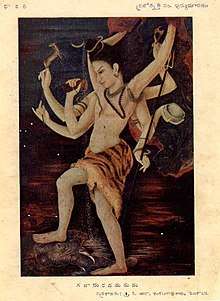 |
Some sages doubting the omnipotence of the god Shiva created an elephant and challenged the god to a duel.[13] Shiva took the form of Gajasamharamurti or "slayer of the elephant" and killed the elephant and wore its skin as a garment.[13] As per another version, the sages residing in Tharukavana wanted Shiva to repent for his act of coming as Bhikshatana and inducing their wives to get them into conjugal mood. They created an elephant to fight against Shiva. Shiva tore open the elephant, whose skin started burning. The elphant fell in the Panchamuga tank opposite to the temple. Shiva is believed to have dipped in the northeast part of the tank and emerged from the southwest part of the tank. The aspect of Shiva is also known as "Kirthivasa" or "one who wears an elephant skin as garment".[14] Vazhuvur is also one of the places where Siva danced his cosmic dance to crush the demon of ignorance.[14] Since the demon Taraka inhabited this place, the forest is named Tharuka Vanam (the forest of Taruka).[15] The place has other names like Parakayilayam, Gananbumi, Suyathapuri and Piplaraynam. During the great deluge, the village alone was not affected, leading to the Tamil name of Vazhuvur (the place which is not affected).[16] |
| 8 | Veerateeswarar temple, Thiruvirkudi | .jpg) |
Jalandhara under the aegies of the Guru Sukracharya became very powerful. He defeated all celestial deities and Indra. Indra along with other deities prayed to Shiva to destroy the demon. Jalandhara in the meanwhile, married Tulasi (also called Vrinda), the daughter of the Asura Kalanemi. Her chastity and devotion to the husband, made him even more powerful. Shiva appeared as Veerateewarar (also called Jalandharavathamurthy) There was severe fight between the Shiva and Jalandhara in Virkudi, with both showing equal prowess. Each time Shiva appeared overpowering Jalandhara, Tulasi's chastity was sving him. Vishnu in the meanwhile tricked Tulasi by appearing as a sage and bringing bad dreams to her. She approached the sage for relief, who created a mirage showing Jalandhara being killed by Shiva with the sage bringing him back to life. Tulasi was happy with the replica of Jalandhar, who was Vishnu himself. She lost her chastity on account of the incident. Shiva in the meanwhile, challenged Jalandhara to break a chariot, which he could not. Shiva killed the demon with the chariot. Tulasi, in the meanwhile cursed Vishnu that he would turn into a stone. Pleased by the devotion of her, Vishnu gave her a boon that she will be part of every Vishnu worship and she would acquire equal place in his heart as Lakshmi. Jalandhar, being born out of Shiva, got merged into Shiva.[17] |
List of temples based on architecture
Notes
- P., Karthigayan (2016). History of Medical and Spiritual Sciences of Siddhas of Tamil Nadu. Notion Press. p. 388. ISBN 9789352065523.
- "Appar Tevaram -2" (PDF). Projectmadurai.org. pp. 14–6. Retrieved 16 July 2011.
- "Slaying of Demon Andaka". Templenet. 2011. Retrieved 28 March 2016.
- Krishna, Nanditha (2007). The Book of Demons. Penguin UK. p. 252. ISBN 9789351181446.
- Madhavan 2014, p. 93
- Kapoor, Subodh (2002). The Indian Encyclopaedia: La Behmen-Maheya. Genesis Publishing Pvt Ltd. p. 4467. ISBN 9788177552713.
- Daniel Ingalls (1968). Sanskrit poetry, from Vidyākara's "Treasury". Harvard University Press. p. 58. ISBN 978-0-674-78865-7.
- Klaus Klostermaier, (2000) Hinduism: A Short History. Oxford: One World Publications.
- Wendy Doniger O'Flaherty, (1975) Hindu Myths: A Sourcebook Translated from the Sanskrit. London: Penguin Books, p.157-159
- R. 2019, p. 129-33
- V., Meena (1974). Temples in South India (1st ed.). Kanniyakumari: Harikumar Arts. p. 37.
- R. 2019, p. 115-9
- P. V. Jagadisa Ayyar (1920). South Indian shrines: illustrated. Madras Times Printing and Pub. Co. p. 281.
- Tourist Guide to Tamil Nadu. Sura Books. p. 64. ISBN 978-81-7478-177-2.
- Venkataraman, Sekar (2019). Temples of Forgotten Glory A Wide Angle Exposition. Notion Press. p. 185. ISBN 9781645876250.
- R. 2019, p. 126-8
- R. 2019, p. 120-5
References
- Madhavan, Chithra. Vishnu temples of South India volume 4. Chennai: Alpha Land Books Pvt. Ltd. ISBN 978-81-908445-3-6.
- R., Ponnammal (2019). 108 Thennaga Shivasthalangal (in Tamil). Giri Trading Agency Private Limited. ISBN 978-81-7950-707-0.
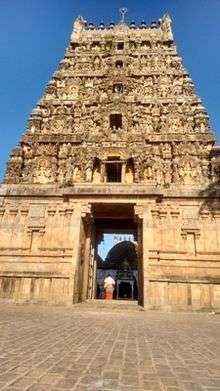
.jpg)
.jpg)
